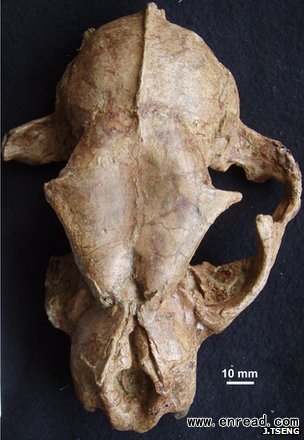|
  
- UID
- 86155
- 帖子
- 60350
- 积分
- 64892
- 学分
- 591606 个
- 金币
- 810 个
- 性别
- 男
- 在线时间
- 2779 小时

|
|
The oldest big cat fossils ever found - from a previously unknown species "similar to a snow leopard" - have been unearthed in the Himalayas.
喜马拉雅山地区一块最古老的猫科动物化石被发掘出土——这是一种“类似于雪豹”的未知物种。

It is rare for such an ancient carnivore fossil to be so well preserved
The skull fragments of the newly-named Panthera blytheae have been dated between 4.1 and 5.95 million years old.
Their discovery in Tibet supports the theory that big cats evolved in central Asia - not Africa - and spread outward.
The findings by US and Chinese palaeontologists(古生物学家) are published in the Royal Society journal Proceedings B.
They used both anatomical and DNA data to determine that the skulls belonged to an extinct big cat, whose territory appears to overlap many of the species we know today.
"This cat is a sister of living snow leopards - it has a broad forehead and a short face. But it's a little smaller - the size of clouded leopards," said lead author Dr Jack Tseng of the University of Southern California.
"This ties up a lot of questions we had on how these animals evolved and spread throughout the world.
"Biologists had hypothesised that big cats originated in Asia. But there was a division between the DNA data and the fossil record."
Surprising find
The so-called "big cats" - the Pantherinae subfamily - includes lions, jaguars, tigers, leopards, snow leopards, and clouded leopards.
DNA evidence suggests they diverged from their cousins the Felinae - which includes cougars, lynxes, and domestic cats - about 6.37 million years ago.
But the earliest fossils previously found were just 3.6 million years old - tooth fragments uncovered at Laetoli in Tanzania, the famous hominin(古人类) site excavated by Mary Leakey in the 1970s.
The new fossils were dug up on an expedition in 2010 in the remote Zanda Basin in southwestern Tibet, by a team including Dr Tseng and his wife Juan Liu - a fellow palaeontologist.
They found over 100 bones deposited by a river eroding out of a cliff, including the crushed - but largely complete - remains of a big cat skull.
"We were very surprised to find a cat fossil in that basin," Dr Tseng told BBC News.
"Usually we find antelopes and rhinos, but this site was special. We found multiple carnivores - badgers, weasels and foxes."
Among the bones were seven skull fragments, belonging to at least three individual cats, including one nearly complete skull.
The fragments were dated using magnetostratigraphy - which relies on historical reversals in the Earth's magnetic field recorded in layers of rock.
They ranged between 4.10 and 5.95 million years old, the complete skull being around 4.4 million years of age.
"This is a very significant finding - it fills a very wide gap in the fossil record," said Dr Manabu Sakamoto of the University of Bristol, an expert on Pantherinae evolution.
"The discovery presents strong support for the Asian origin hypothesis for the big cats.
"It gives us a great insight into what early big cats may have looked like and where they may have lived."
更多英语新闻
|
|